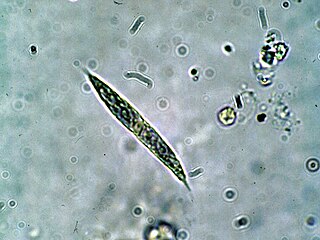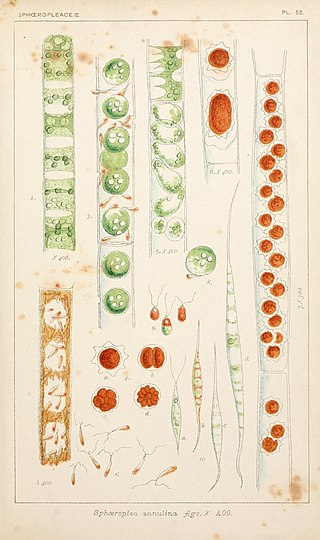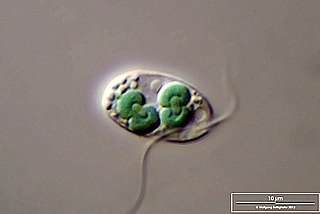
Tetradesmus dimorphus is a freshwater unicellular green algae in the class Chlorophyceae. The name means "having two forms".

Selenastraceae is a family of green algae in the order Sphaeropleales. Members of this family are common components of the phytoplankton in freshwater habitats worldwide. A few species have been found in brackish and marine habitats, such as in the Baltic Sea.

Botryococcus is a genus of green algae. The cells form an irregularly shaped aggregate. Thin filaments connect the cells. The cell body is ovoid, 6 to 10 μm long, and 3 to 6 μm wide. Fossils of the genus are known since Precambrian times, and form the single largest biological contributor to crude oil, and are a major component of oil shales.
Actinochloris is a genus of green algae, in the family Actinochloridaceae, with a single species Actinochloris sphaerica. It is a subaerial to terrestrial alga.

Asterococcus is a genus of green algae in the order Chlamydomonadales. It is planktonic in freshwater ponds and lakes, or benthic within mires and swamps. It is a common and widespread genus, but is rarely abundant.

Dimorphococcus is a genus of fresh water green algae in the family Scenedesmaceae. It is found as a component of the phytoplankton of freshwater ponds, lakes, and peat bogs. It is widespread, but usually not very common.
Podohedriella is a genus of green algae in the family Selenastraceae. It is found in freshwater habitats or on damp wood.
Polyedriopsis is a genus of green algae in the order Sphaeropleales. As of February 2022, it contained a single species, Polyedriopsis spinulosa. It is found worldwide in freshwater habitats as phytoplankton, but is rare.
Pseudoschroederia is a genus of green algae in the family Characiaceae. It is planktonic in freshwater habitats, and probably has a cosmopolitan distribution. The genus Pseudoschroederia was circumscribed by Eberhard Hegewald and Eberhard Schnepf in 1986. The genus was distinguished from the similar Schroederia by being heteropolar and differing cell structure. However, some authors do not consider the genera to be separate.

Quadrigula is a genus of green algae in the family Selenastraceae. It is commonly found in freshwater habitats as phytoplankton.

Sphaeroplea is a genus of green algae in the family Sphaeropleaceae. It was first circumscribed by the Swedish botanist Carl Adolph Agardh in 1824.
Deuterocharacium is a genus of green algae in the family Characiaceae. It is found in freshwater habitats, attached to algae or detritus. It is rare and has only been recorded from Europe.
Chlorotetraedron is a genus of green algae, in the family Neochloridaceae. The name may also be written as Chlorotetraëdon. It is found as freshwater plankton or in soil.
Korshikoviella is a genus of green algae in the family Characiaceae.

Cyanophora paradoxa is a freshwater species of Glaucophyte that is used as a model organism. C. paradoxa has two cyanelles or chloroplasts where photosynthesis occurs. Cyanelles are unusual organelles in that they retain a rudimentary peptidoglycan wall. The cyanelle genome of C. paradoxa strain LB 555 was sequenced and published in 1995. The nuclear genome was also sequenced and published in 2012.
Cecidochloris is a green algae genus in the family Chlorangiellaceae. It occurs in freshwater. However, it has only been reported so far from Europe, with an additional species from India that is incompletely described.

Tetradesmus obliquus is a green algae species of the family Scenedesmaceae. It is commonly known by its synonym, Scenedesmus obliquus. It is a common species found in a variety of freshwater habitats.

Cosmarium botrytis is a species of green algae in the family Desmidiaceae. It is a freshwater species with a worldwide distribution, and has been recorded from all continents.

Apiocystis is a genus of algae belonging to the family Tetrasporaceae. It is found attached to freshwater aquatic algae or plants. The species of this genus are found in Europe and Northern America, and are widespread but generally uncommon.
Chlorangiella is a genus of microscopic algae, the type genus of the family Chlorangiellaceae. The name Chlorangiella was coined by Giovanni Battista de Toni in 1889. It is a nomen novum for Chlorangium F.Stein.










